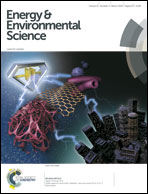Bioelectrodes modified with chitosan for long-term energy supply from the body
Abstract
A 3D nanofibrous network of compressed chitosan in the presence of genipin as the cross-linker, carbon nanotubes and laccase constitutes a new design to enhance the stability and the biocompatibility of biocathodes. The in vitro delivered current was around −0.3 mA mL−1 for 20 days under continuous discharge. A thin film made of chitosan cross-linked with genipin was synthesized and optimized for oxygen and glucose diffusion. This film was used as a biocompatible barrier on the surface of biocathodes implanted in rats. The biocathodes remained operational after 167 days in vivo. This biocathode design minimised the inflammatory response in the first two weeks after implantation. After several months, the growth of macrophages was observed. The electrical connection and the catalytic activity of the enzyme entrapped into the biocathode were demonstrated after almost 6 months of implantation by the ex vivo measurement of the OCP (0.45 V to 0.48 V) and the delivered current (−0.6 mA mL−1) under optimal conditions.


 Please wait while we load your content...
Please wait while we load your content...